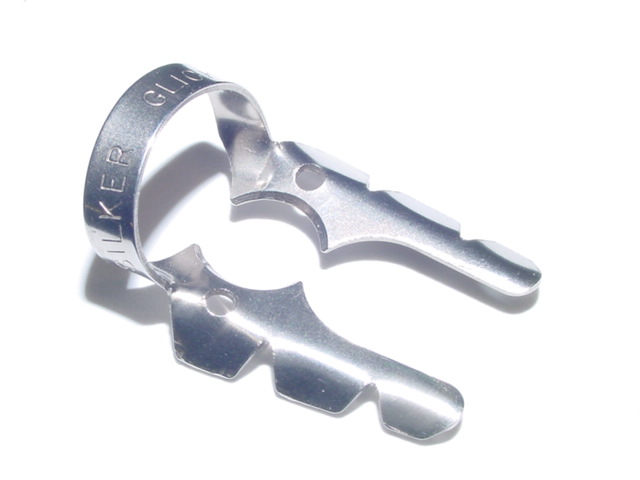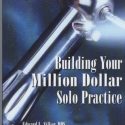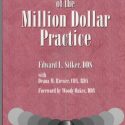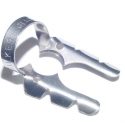This text is intended to reveal to fellow dentists and/or dental field personnel as much information as possible about how a new start up dental practice in a town of 524 population (Deerwood, Minnesota) grew from zero patients in May of 1990 to a Million Dollar Annual Solo Practice in 1994.
This text's intention is to describe how this occurred. Your author is not so naive or presumptuous to suggest this is the only way of doing any of the following procedures or that this is the only way to construct the physical plant or the only way to equip it.
However, this is what worked and if you can benefit in any way from our climb up the elusive learning curve it would fulfill the purpose of this book.
This book will become your constant reference on efficiency, flexibility and effectiveness in your dental practice. It will help to make your practice more enjoyable while increasing your profits exponentially.
Reviews
‘Building Your Million Dollar Solo Practice': A book review
December 10, 2002
I had been talking to a 35-year-old doctor from California by phone while researching an article. He impressed me when he said he had paid off all his debts—student loans and new practice loans five years after graduation.
How did you do that? I asked, incredulous.
I credit my financial success to my ‘dental bible.'
What ‘bible'? I asked, fully expecting a detour into religion.
Building Your Million Dollar Solo Practice by Dr. Edward Silker, he said.
Never heard of it, I said.
Shortly after hanging up, curiosity got the best of me. An Internet search brought me Dr. Silker, as it does just about everything else. Soon after, here's what I learned from reading Building Your Million Dollar Solo Practice , ($59, Silk Pages Publishing, 1995) and talking with its author.
Background on Edward Silker, DDS
Dr. Silker graduated from University of Minnesota School of Dentistry in 1973, and obtained his MBA in 1997. He is the owner of The Smile Center, Deerwood, MN, which opened in a town with a 524 population. The practice opened in 1990 with zero patients and made its first annual million dollars in 1994. Dr. Silker has produced one video ( A Day at The Smile Center ) and two books besides the one reviewed here ( Details of the Million Dollar Practice and How the Wealthy Get That Way ). He also describes himself as an inventor and entrepreneur (sells his own unique rubber dam clamp for $15).
Here are some factoids about Dr. Silker, who, incidentally, looks somewhat like Albert Einstein:
He employs 10 associate dentists;
The Smile Center has 16 operatories and 25 chairs in its waiting room;
Hours: seven days a week;
55 people on his payroll;
During the 1980s, he ran a 24-hour, 365-days-a-year dental clinic in Phoenix where he was the first employer of a newly graduated Dr. Howard Farran. Dr. Farran, dentistry's bad boy, at 39 is today also a millionaire practice management guru and is a part-time practicing dentist;
Almost named this book What They Didn't Teach You in Dental School because he quipped, The guy who went belly up is the one who teaches you how to do business in dental school.
Organization of the ‘bible'
Here are the titles of the book's 31 chapters: Building your million dollar practice, The new patient's first trip to the dental office, The learning curve, Efficiency, Efficiency in action, Flexibility, Scheduling, The patient factor, Tray and operatory set-ups, Nitrous oxide/oxygen analgesia, Rubber dam—modified rubber dam technique, Pedodontics, Root canal treatment, Removable prosthetics, Fixed prosthetics, Love thy lab, Operative dentistry, Personality and communication, Third party payment, Expenses, Marketing, Accounting and the business side of dentistry, A trip to the banker, Your mission statement, Goal setting, The physical plant, The telephone system, Open operatory concept, Dental equipment, Chalk talks, In-house laboratory.
What's impressive about these chapters is that unlike most dental practice management books, they give instructional tips—not just espouse philosophy. Dr. Silker provides detailed how-tos that are useful for dentists flexible enough to change their inefficient ways. For example, color photos show recommended rubber dam and tray set-up configurations. Chart abbreviations are given, as are schematics for ergonomic traffic flow.
The appendixes include inspirational quotations, reading suggestions, and supplier phone numbers.
Motivation for authoring
Knowing it is not always wise to trust advice published by a dentist you don't know, I wanted to find out why he wrote the book. Clearly, books are ego-gratifying legacy-builders, but was there more?
He starts Chapter 1 with a Zig Zigler quote: You can get everything in life that you want -- if you'll just help enough other people get what they want.
Getting Dr. Silker on the phone two days before his annual four-month trip to Hawaii was tricky (while on the islands, he swims, watches the market, and tinkers with his stocks). He did talk with me for 10 minutes, probably doing a crown prep while an assistant held the phone to his head. Here's what he said:
What I've noticed over the years is that dentists make top pay but live just above their means, which is also true of attorneys and physicians. They are not good managers of their money. I've had over 100 associates over the years, and I wanted to write a book to help, Dr. Silker said, sounding neither egocentric nor like some millionaire. He added, Dentistry has historically been lucrative enough so that dentists can make a good living without being efficient.
Principles of ‘Million Dollar Solo Practice'
In no particular order, what follows are several of the core messages communicated in Dr. Silker's book.
Financial rewards for the young dentist should be less of a priority than gaining experience, otherwise known as attacking that learning curve. You worked long hours in dental school for little return, so keep it up out of school and you will maximize repetition and time-motion studies to improve your efficiency.
Practice six-handed dentistry; meaning your assistant has an assistant, so your eyes almost never (95% of time on mouth, 5% elsewhere) leave the patient's dentition -- auxiliaries do all the rest. Never put down the mirror, or look for a tool, and minimize the number of hand transfers.
Standardize tray set-ups in all operatories
Staff should be so highly trained down to minute detail that they train the new staff, and they could (illegally) run the practice if you called in dead. Find out what is legal for hygienists and assistants to perform in your state and have them do the maximum, including prediagnosing dental and oral conditions.
Fit in all emergency patients, even new ones, by telling them to bring a book in case you have to stop and start to get existing patients taken care of in a timely manner. Emergencies are an unexpected financial boon, and a way to land an instantly loyal patient is to get him or her out of pain fast .
If staff have trouble engaging patients in conversation, questions should follow FORM: Family, Occupation, Recreation, and Motivation.
Conclusion
At the end of October 2001, Dr. Silker quit practicing dentistry. I was worried about what would happen. Nothing collapsed. In fact, it is going better since I left, he said, begrudgingly. Sure, he comes in, does some work now and then, but he doesn't have to.
Some dentists may pooh-pooh his practices as solely money-motivated, but he insists otherwise. The only difference between he and a dentist in the poor house is while they both do quality dentistry, Dr. Silker does every aspect as fast as it can be humanly done while leveraging the power of delegation—earning profit while others' do the work so you don't have to.
We don't care what my detractors say as long as they are talking, Dr. Silker said with a laugh.
This writer's recommendation of the book doesn't count, as I am not a dentist. Knowing the book is recommended reading in some dental schools, and by young dentists, however, is a pretty good testimonial. A disclaimer at the beginning of the text says if you don't agree, you can send it back for a full refund.
This column is prepared by Janyce Hamilton, a Chicago area freelance journalist who specializes in covering dentistry. New columns will be put online on a monthly basis. If you have a suggestion for topics to be covered, or any comments on this column, drop us a line, review@cds.org .
©2002 Chicago Dental Society
Exctracted from Chicago Dental Society
Extracted from Southeastern Society of Pediatric Dentistry
Title: Building Your Million Dollar Solo Practice
By: Edward L. Silker, D.D.S.
Pages: 413
Publisher: Silk Pages Publishing, Co.
Year: 1995
Reviewer: Edward S. Nacht, D.D.S., F.A.C.D., F.I.C.D
Private Practice of Pediatric Dentistry, Plantation, FL.
Every pediatric dentist in a dental office should consider having this book. The text's 31 chapters focus on its themes of practical management techniques. Setting goals and motivational common sense. Each chapter is full of good sense. With emphasis on detail, concise planning and efficiency, which pediatric dentists can apply to their practices. The author stresses ultimate efficiency as a goal to work toward constantly. Dr. Silker emphasizes full legal delegation of responsibilities to the staff at all times.
Some of the more interesting chapters include Chapter 3, The New Patient’s First Trip; Chapter 5, Efficiency in Action; Chapter 7, Scheduling; Chapter 32, Marketing; and Chapter 25, Goal Setting.
If the book has a shortcoming, it’s the suggestion in the author’s example that nitrous oxide is used on all children undergoing restorative dentistry. There is no mention of other behavior management techniques or other areas of pediatric dentistry.
If you want to increase your efficiency and practice management skills, I recommend this book.
Extracted from Australian Dental Association(ADA)
ADA (NSW) Book Review, 9 November 1995.
Building Your Million Dollar Solo Practice, E. L. Silker. First edition. Silk Pages Publishing, Lakeshore, MN 56468, USA. Soft cover, b&w and Color Illustrations, 415 pages. ISBN 0-9645815-0-7. Recommended retail price US$59.95. Our copy courtesy from the publisher is available for borrowing now from the Hardwick Memorial Library, ADA office, 71-73 Lithgow Street, St. Leonards 2065.
Your reviewer assumed from the title that this book would be a classic example of American hype. He was wrong. It is beautifully laid out, is easy to read and has valuable advice, recommendations and information on practically every page. A dentist following even some of the suggestions would certainly improve productivity, income and patient referrals. But don’t expect to achieve a solo million dollar turnover in the fourth year, as the author did. He started out in a village with 524 residents and probably squatted!
The book itself is unusual on several counts. It has no index (and doesn’t need one). It has an endorsement from the Professional Economics Bureau of America (and doesn’t need one). It has an introduction footnote explaining and excusing any gender bias in the text. It has a disclaimer covering any typographical or content errors and loss or damage arising therefrom, followed by a statement (in bold face capitals): “IF YOU DO NOT WISH TO BE BOUND BY THE ABOVE. YOU MAY RETURN THIS BOOK TO THE PUBLISHER FOR A FULL REFUND.” But you are not likely to do this.
The foregoing illustrates by example the author’s persona. He is careful, concerned and caring. He is also ‘switched on’. He believes in the maxim: ‘strive to discover your patient’s priorities and value system and integrate their desireswith your broad knowledge of dentristry to develop a treatment decision which is in your patient’s best interest and your practice will flourish’.
A thorough review of the scope of this book would require many pages. A digest of the chapters is: building your practice, new patients, the learning curve, efficiency, flexibility, patients, tray set-ups, nitrous oxide, rubber dam, pedodontics, RCT, prosthetics, laboratory, operative personality and communication, dental insurance, expenses, marketing, accounting, banks, mission statement, goals, plant, telephones, layout, dental equipment, staff talks, in-house laboratory, maxims, quotes, reading list and bibliography. Nothing is left out, and your reviewer believes that any reader will find a useful tip in every one of the 31 chapters.
The writer stresses the sharing of responsibilities, the delegation of tasks, strong interpersonal relationships with the staff and the patients, efficiency of operation and satisfying the patient’s requirements above all else. A patient in pain is seen immediately, and then often agrees to a RCT and crown. Here are some random observations by your reviewer: Dental assistants relate to patients by asking about Family, Occupation, Recreation, Motivation (FORM). Scheduling is left to assistants, who know the patients and the work and thus plan the dentist’s activities so she/he only does what a dentist must do. All other work is done by ancillaries.
All surgeries are arranged with standard trays, all identical. Everything required is on hand. The chair side assistant has an assistant. Rubber dam is used extensively, but broadly, to isolate several teeth, to ‘keep the tongue and cheek out of the operating field’. Children are treated as clients, and spoken to as such: How old are you? Six. How old would you like to be? Eight. Why? And so on.
Root canal therapy is promoted, first, to remove the source of pain and secondly, to provide the basis for a subsequent crown, but the writer suggests that you should offer alternatives until you get a fit with the patient’s emotional and financial situation. About the latter, this is left to the clerical staff, and they sort this out and reach agreement before the dentist actually performs the service. Unpaid accounts are rare.
By using ancillary staff, complete dentures are completed in four appointments, but the author makes the point that there is no shame in telling the patient with a bag full of unsatisfactory dentures that they should seek treatment elsewhere. He offers ten different ways of explaining to the patient that the expensive crown is the best form of treatment.
It has long been the view of your reviewer that communication and personality represent the major factors in successful dental practice. This is not to denigrate professional skill. One assumes that most dentists have this. The trick is to convince the patient that you are providing this skill. This book tells you how to do it.
The chapter on dental insurance may not be relevant in Australia, but the sections on expenses and marketing certainly are, as are the suggested surgery designs. With all these positives, is there a negative in this book? Yes, there is. To test denture fit, no one who is well informed uses pressure indicating paste (PIP) any more, they use Fit Checker!
Barrie Gillings
This is a book review that appeared in the Dentist Weekly of Sept. 95. Published by Fackler and Wagenbauer GMBH. Munchen, Germany
It is current knowledge that students in our universities receive very little information about the business world in which they will find themselves upon graduation.
When a young dentist starts his practice, 90% of his knowledge should be devoted to the business part of his practice, especially as in the last few years there has been more emphasis on the business area of dentistry all over the world. Our dentists are particularly badly prepared for these changes. Even the clinical side of dentistry has drastically changed. It must be recognized that the dental practice is also just another business.
Doctor Silker, in his new book, particularly addresses the technical changes and explains in detail the modern methods that will result in a successful practice. The book gives many tips which will help a beginning dentist to rapid achievement. This can easily guide you to a million dollar solo practice. The author, in 31 sections, details the success-building steps for the young dentist.
The book is based on the practical experience of the Author. He states, “There is no easy path to success.” But he details in well-explained points the steps necessary for a successful practice.
Dr. Silker is the owner of a practice, a businessman and an inventor. In his book he uses again and again examples that he established in his own practice. He states that the medical side is often not as important as the business side in his profession. After graduation Dr. Silker established a solo practice from 1973 to 1979. From 1980 to 1989 he joined Dr. Herman H. Boehme in Phoenix, Arizona in a multiple-unit practice. They started with one office and expanded to four separate units with 24 hour service, 365 days of the year. Their basic principle was the acknowledgement that dentistry is a business, which for patients and doctors is the best solution for dental problems.
“Building Your Million Dollar Solo Practice” Silker, Silk Pages Publishing 1995
Review for the “General Dental Practitioner” Magazine
Journal of the General Dental Practitioners’ Association, UK
By Derek Watson DGDP BDS LDS RCS
House can you resist the temptation to review a book with a name like that? This is a detailed look into the mind of a dentist who grosses $1,000,000 a year (he publishes a letter of certification at the beginning of the book). If your immediate reaction is – “well he must be doing some extremely dodgy treatment!”, then you are the sort of person who should read this book.
Silker’s methods are astounding. He is not a dentist so much as an efficiency expert who uses dentistry to provide his income. We can all benefit from his research – it has all been developed in general practice. He uses four chairs arranged side by side like in dental school. He always completes all the patient’s dentistry on the first visit, when possible. He will only do jobs that only he can do and in this book he has set out his strategies for every conceivable situation from carrying out a root canal treatment to catching up when late.
Some of the stuff that his “assistants” do cannot be done here, but he knows that. He describes it as being written “from the TRENCHES where we (as dentists) live.” The book even includes a floor diagram for a complete new practice! And this is a dentist who sets himself a target of $4,300 gross a day. ($3,846 a day would produce $1m, but he says that $4,300 gives a “nice allowance for recreation time”).
There are some frustrating gaps in the narrative, which you would expect as he is telling his own story. The book could have been more structur3ed and complete, but that would have taken away the spontaneity, the exuberance with which the author writes. If you want a book that covers all the subjects that are usually left out, from traffic counts to children that wiggle, that is also funny, then I recommend this book.




